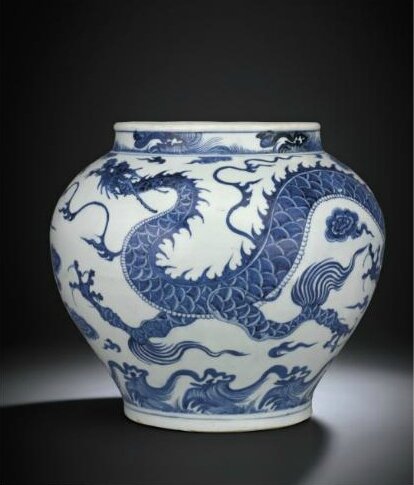A magnificent and very rare white and blue 'Dragon' jar, guan, Yuan dynasty (1279-1368)
A magnificent and very rare white and blue 'Dragon' jar, guan, Yuan dynasty (1279-1368). Photo Christie's Image Ltd 2014
Of globular form, the jar is sturdily potted with a high rounded shoulder rising to a straight neck decorated with waves motif and a lipped rim. The exterior is exquisitely painted in brilliant cobalt of deep sapphire-blue tone with a single four-clawed dragon, powerfully striding to the left with its head raised in pursuit of a flaming pearl among large ruyi cloud clusters and jagged flames above waves of water surrounding the base of the foot. 12 1/4 in. (31 cm.) high, box. Estimate HK$12,000,000 – HK$18,000,000 ($1,554,872 - $2,332,309). Unsold.
THE PROPERTY OF A GENTLEMAN
Notes: The present jar, richly painted in cobalt blue, is among the best examples of the very rare Yuan blue and white wares decorated with dragons. Of the few published jars designed with dragons as a major motif on the body, only two comparable examples of this large size and decoration are known. The first is in the Tokyo National Museum Collection, illustrated in The World's Great Collections, Oriental Ceramics, vol. 1, Kodansha, Tokyo, 1982, no. 18; and the second guan was sold at Sotheby's Hong Kong, 31 October 2004, lot 12. A smaller jar (22 cm. high) with a diaper band around the mouth rim was sold at Christie's Hong Kong, 27 April 1997, lot 686.
There is also a group of related single dragon themed jars decorated with additional minor bands, for example the guan designed with a register of floral scrolls on the shoulder and lappets above the foot, illustrated in Chinese Ceramics in the Idemitsu Collection, Tokyo, 1987, pl. 142. Another dragon jar of a striding dragon above similar waves but with a band of miscellaneous treasures, anbaxian, motifs within lappets on the shoulder, was sold at Sotheby's Hong Kong, 2 May 2000, lot 650.
Other jars with dragons forming the major decorative band include the example excavated in 1966 from a hoard found at Huxi Dadui, Taoxi Town, Jintan County, Jiangsu province, included in the exhibition, Art of Yuan Blue-and-White Porcelain, Shanghai Museum, 2012, and illustrated in the Catalogue, p. 189, no. 63. It is interesting to note that the excavated example, now housed at the Zhenjian Museum, was discovered together with a group of silver including a dish inscribed with an Arabic inscription dating to the 1314, ibid., p. 188.
Jars designed with dragons within a minor band at the shoulder include the example illustrated by J. Ayers (ed.), Chinese Ceramics in the Topkapi Saray Museum, London, 1986, vol II, p. 407, col. no. 586; and the jar designed with forward and backward-looking dragons, previously sold in at Christie's Tokyo, 27 May 1969, lot 179, and later in the Ataka Collection, illustrated by T. Nakano, The Panoramic Views of Chinese Patterns, Japan, 1985, col. pl. 9.
Compare also to the famous pair of 'David' vases in the Percival David Foundation, now housed in the British Museum, dated to 1351, painted with similarly rendered dragons in cobalt blue. The treatment of the dragon scales, each shaped like an axe and picked out in varying shades of blue, and the notably narrow dragon necks, on both the current jar and on the 'David' vases, are particularly alike, strongly suggesting they might have been produced around the same period.
Christie's. THROUGH CONNOISSEURS' EYES - WORKS OF ART FOR THE EMPEROR, 28 May 2014, Hong Kong - http://www.christies.com/

/https%3A%2F%2Fprofilepics.canalblog.com%2Fprofilepics%2F1%2F0%2F100183.jpg)
/https%3A%2F%2Fstorage.canalblog.com%2F03%2F02%2F119589%2F96711876_o.jpg)
/https%3A%2F%2Fstorage.canalblog.com%2F11%2F31%2F119589%2F94773502_o.jpg)
/https%3A%2F%2Fstorage.canalblog.com%2F20%2F83%2F119589%2F94772815_o.jpg)
/https%3A%2F%2Fstorage.canalblog.com%2F26%2F72%2F119589%2F75604929_o.jpg)
/https%3A%2F%2Fstorage.canalblog.com%2F59%2F60%2F119589%2F26458628_o.jpg)



/image%2F1371349%2F20240416%2Fob_2a8420_437713933-1652609748842371-16764302136.jpg)
/image%2F1371349%2F20240414%2Fob_83ee65_2024-nyr-22642-0954-000-a-blue-and-whi.jpg)
/image%2F1371349%2F20240414%2Fob_15808c_2024-nyr-22642-0953-000-a-blue-and-whi.jpg)
/image%2F1371349%2F20240414%2Fob_e54295_2024-nyr-22642-0952-000-a-rare-blue-an.jpg)